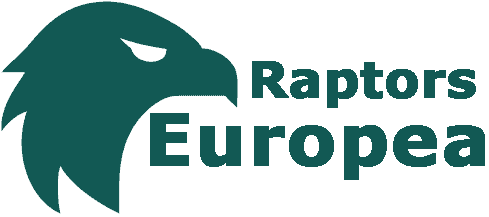Red footed Falcon
(Falco vespertinus)
The Red-footed Falcon is an agile small falcon species that feeds primarily on insects, and breeds in the eastern part of Europe.

The preferred habitat of Red footed Falcons is open landscape with low vegetation, which allows them to hunt insects effectively.
Unfortunately, the overall population trend of the Red-footed Falcon has been steadily declining over many decades, which raises concern for the future of this elegant falcon species.
The Red footed Falcon shares this plight with many other species that prefer open landscapes, due to the transformation of traditional extensive agriculture to more intensive modern agriculture.
Red-footed Falcon facts
The Red-footed Falcon is a small raptor found in open landscapes of eastern Europe, and migrates to southern Africa during the winter.
Red footed Falcon size
The Red-footed Falcon is a small falcon species that resembles a Lesser Kestrel (Falco naumanni) or Merlin (Falco columbarius) in overall size.
- Wingspan: 65-78 cm
- Length: 28-31 cm
- Weight: 130-200 g (female), 110-190 g (male)
Due to its small size, the Red footed Falcon doesn’t immediately look like a raptor, and you may need to look twice to recognize it as such.
Appearance
The Red footed Falcon is a small falcon species that is often seen hunting for insects at low altitudes. The male is uniformly dark grey (similar to the dark phase of the Eleonora’s Falcon), which makes it unmistakable. Female and juvenile Red-footed Falcons are brown on top, with a light rufous underside.

Sexual dimorphism
Similar to most European bird of prey species, the female Red-footed Falcon is larger than the male, but there is a considerable size overlap between the sexes. In addition to this, there is also a difference in color: adult males are uniformly dark grey, while adult females are dark brown on top, and light brown below.
Lifespan
A maximum age of 12 years has been recorded in the wild.
Scientific name and taxonomy
The scientific name of the Red footed Falcon is Falco vespertinus. No subspecies are known, but the Red-footed Falcon is closely related to the Eurasian Hobby (Falco subbuteo) and the Eleonora’s Falcon (Falco eleonorae), although it is smaller than both of these species
Outside of Europe, it is also closely related to the Sooty Falcon (Falco concolor), which occurs in Africa.
Red-footed Falcon distribution
The Red-footed Falcon is an eastern species that occurs in many eastern European countries, with its westernmost breeding populations found in Italy and Austria. Outside of Europe, its distribution stretches eastwards to Siberia.
Red footed Falcon habitat
The Red-footed Falcon prefers open landscapes, including steppes and grassland, as well as forests interspersed with open landscapes. It is a species of the lowlands, and is rarely found at altitudes higher than 300 meters above sea level.
Red footed Falcon population size
The European population of the Red footed Falcon is estimated to be between 26,000 and 39,000 breeding pairs, of which the largest population is found in the European part of Russia (with up to 30,000 pairs), followed by Ukraine (up to 5,100 pairs) and Romania (up to 1,600 pairs).
Red footed Falcon behavior
The Red footed Falcon uses similar foraging tactics to the Eurasian Hobby, with which it is often seen together in locations where they coexist. Its main food source, large insects, are taken either in the air or on the ground.
Feeding and diet
The main food source of the Red footed Falcon are large insects, such as dragonflies, grasshoppers, locusts, and others. Outside of the breeding season, it feeds almost exclusively on insects.
However, during the breeding season, it also takes small rodents, such as voles, similar to the Common Kestrel (Falco tinnunculus).
Breeding
Similar to all European species of falcons, the Red footed Falcon doesn’t build its own nest, but instead takes over old nests built by other birds, such as crows, buzzards, and rooks. When using rook nests, Red-footed Falcons often nest in small colonies.
The female lays 2-5 eggs, which are incubated for up to 30 days. After hatching, the young Red-footed Falcons stay in the nest for up to 32 days, and are only fed about two weeks after leaving the nest (which is quite short for a raptor species).
Red footed Falcon migration
The Red footed Falcon is strictly migratory, and travels in a long-distance migration all the way to southern Africa. During migration, Red footed Falcons are often observed in central Europe and other areas of Europe that are to the west of their breeding range (especially during the spring migration season).
Red footed Falcon conservation status
The Red footed Falcon has experienced a large decline in its population due to the change in agricultural practices towards more intensive models of cultivation. This is because its main food source, large insects, declines in intensively cultivated farmland.
Due to its steadily declining population, the Red-footed Falcon is classified as “Vulnerable” by BirdLife International, which indicates that this species and its habitat need to be protected in order to change the negative trend.
Threats
The biggest threat to the Red footed Falcon is destruction of habitat due to increasingly industrial agricultural practices used in its breeding range. This type of agriculture leads to the decline of large insects, which are the main food source of Red-footed Falcons.
After habitat loss, the second largest threat to the Red footed Falcon is the decline of the Rook (Corvus frugilegus) in some parts of its breeding range. Old rook nests are a favorite nesting site for Red-footed Falcons, and allow them to breed in colonies that work together to protect each others nests.
